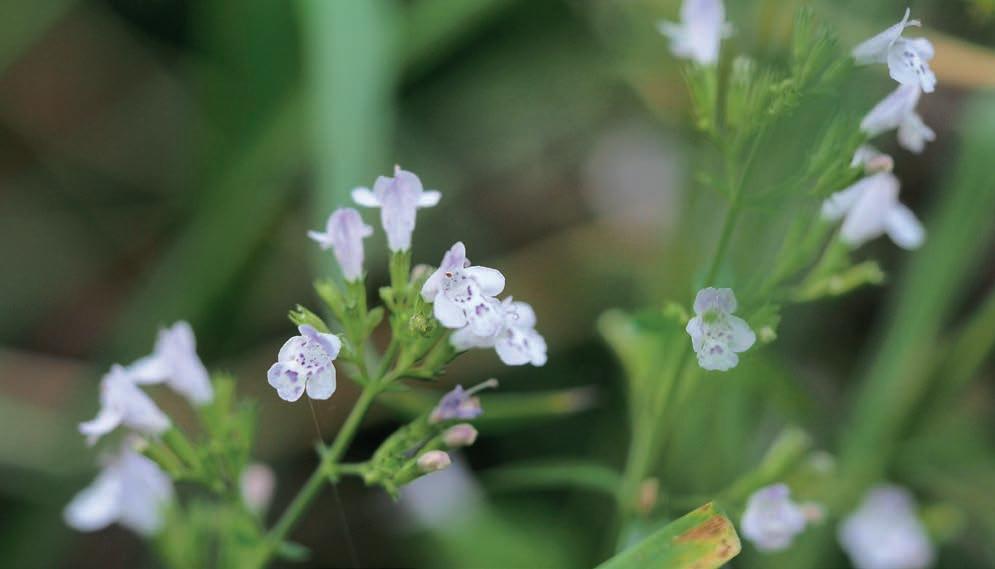
10 minute read
Some interesting plant records from a Winchester allotment
TRISTAN NORTON
Clinopodium nepeta (Lesser Calamint), Winchester, South Hampshire (v.c. 11), September 2021. Photographs by the author.
Advertisement
In mid-September 2021 I paid a visit to Highcliffe Community Allotments in Winchester, a longestablished allotment site in the east of the city, just a few tens of metres inside the v.c.11 South Hampshire boundary. I had kindly been granted access by the Allotment Committee, having asked if I might have a look for interesting plant species. Allotments are often home to some interesting arable species sadly lost from the wider farmed landscape and I thought that it was well worth a look, especially on the baserich soils of the mid-Hampshire chalk. My hunch was right, and I was not to be disappointed.
Like many older allotments (about 120 years old in this case), the site is a varied mix of plots growing vegetables, fruits and flowers from all corners of the globe. It’s fair to say that in common with all the allotment sites I’ve visited, there is a high degree of variability in the ‘weediness’ of plots, ranging from exceptionally neat and tidy to wholly overgrown. As ever in life, there is a middle way sweet-spot, and it is often the tended but not-too-tidy plots that yield the best botanical interest.
I was soon noting some interesting species such as Weasel’s Snout (Misopates orontium) (locally quite frequent) and both Round-leaved Fluellen (Kickxia spuria) and Sharp-leaved Fluellen (K. elatine) so things were looking good for something even more interesting turning up.
I’d spent about a half-hour looking around before walking past a green plastic Brassica cage. The front was slightly unzipped and I happened to glance inside and spot a large ramping-fumitory. The inflorescences were large, pinkish-white and with recurved pedicels – I immediately though it might be White Ramping-fumitory (Fumaria capreolata), a species I was reasonably familiar with, having studied a recently-discovered population from Kings Worthy just outside Winchester. On closer inspection this plant didn’t look quite right: the sepals were not obviously large and toothed as in F. capreolata but were very noticeably ovate and more or less entire, and I was sure that capreolata wouldn’t be quite so pink even late in the season. A quick look at a Fumaria crib I keep on my phone led me to think this must either be Tall Ramping-fumitory (F. bastardii) or Martin’s Ramping-fumitory (F. reuteri).
Following some initial input online from Tim Rich (BSBI Fumaria referee) and Mark Spencer (Vice-county Recorder for London), I was grateful for expert ID opinions from Tony Mundell (v.c.12 Recorder) and Gareth Knass (who had discovered F. reuteri in another Hampshire allotment site in 2010). The consensus was that the plant was likely to be reuteri. I managed to get a fresh sample off to Tim Rich and he was able to confirm the identification. This is the fourth modern Hampshire site for this nationally scarce species: the first from Ampfield in 1964 (as F. martinii), and recent records from allotment sites at Park Gate and Gosport, and arable at Cholderton.
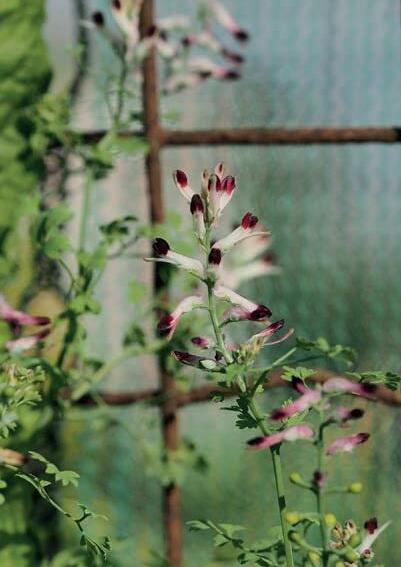
Fumaria reuteri (Martin’s Ramping-fumitory) at the Winchester allotment, September, 2021.
The challenges of Fumaria identification will be known to many. I very much enjoyed using the excellent BSBI Fumaria handbook (Murphy, 2009), the New Flora (Stace, 2019) and various useful online sources to try and get to the bottom of this conundrum myself. The clincher was getting a good look at the stigma. The stigma of F. reuteri has, uniquely amongst this genus, a distinct conical appendage at the apex (see Murphy, 2009). The plant clearly had this feature on the stigmas I examined (see photograph). The upper petal on reuteri is also tipped blackish-red unlike the nominate form of bastardii which is wholly pink, with the blackish tips restricted to the lateral petals. Two very rare bastardii varieties do however exhibit dark-tipped upper petals so, as ever with fumitories, caution is needed.
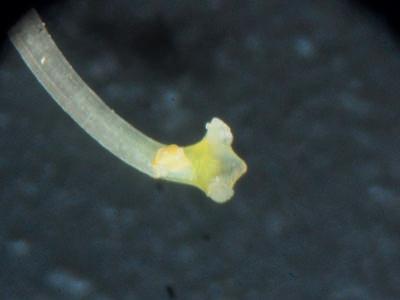
Fumaria reuteri stigma, showing apical projection.
After this find I then carried on searching and noticed a calamint growing amongst some tall grass. Having recently seen plenty of Common Calamint (Clinopodium ascendens) near home I was familiar with the key differences between this species and Lesser Calamint (C. nepeta). Following examination of the relative length of the calyx teeth (these were even lengths) and the presence of protruding hairs from the calyx tube I was feeling confident that this plant was C. nepeta. Given the location there is always the potential for this to have been a planted specimen, although the allotment secretary insisted not. John Poland kindly sent me a list of UK suppliers of C. nepeta and it would appear to be widely available in the horticultural trade. John also noted that the Winchester plant was subtly different from specimens he’d examined in Essex (less grey, less hairy and more aromatic). Whatever its origin, the Winchester plant is the second record for Hampshire, the last being recorded near Morestead (c.4km SSE of the allotments) in 1933. The species was presumed extinct by Brewis et al. (1996) in the Flora of Hampshire.
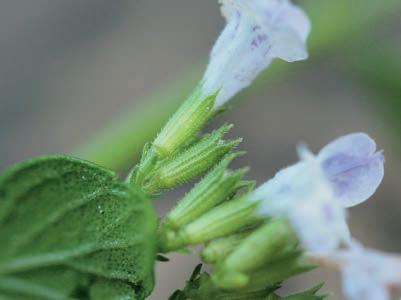
Clinopodium nepeta (Lesser Calamint), showing hairs protruding from even-toothed calyx.
The third interesting plant was found, oddly enough, next to a plot that my wife and I used to tend when we lived in Winchester over ten years ago, although this and the one next door had clearly been untended for some time and was largely overgrown with dense Bramble (Rubus fruticosus agg.) and Hedge Bindweed (Calystegia sepium).
Whilst walking through this area I noticed a strange plant amongst the tangled growth. It was clearly a Rubia species with leaves in whorls, distinctly spiny four-angled stems and strongly toothed leaf edges. The plant was flowering, with a small yellowish calyx of five petals. Now this didn’t look quite right for the Wild Madder (Rubia peregrina) that I was familiar with from trips to Devon. That species was, to my recollection, distinctly dark-green and shiny: this plant was bright apple-green and not shiny at all. I had ‘Stace’ in my bag and was able to discern that Rubia ID is not quite that simple. I was out of my depth and needed help.
I sent some images to Tony Mundell and Martin Rand and Martin was able to provide some insight from European Flora sources. The key feature on the Winchester plant was that the leaf veining formed a complex closed network (is anastomose), with the main and secondary veins turning back on themselves before the leaf margin: this is a feature of Madder (Rubia tinctorum) whereas R. peregrina doesn’t do this to such an obvious extent. The corolla tube is also longer/deeper on tinctorum. A few days later Martin was able to visit the plant and brought along a pressed specimen of R. peregrina for comparison; the identification was confirmed as R. tinctorum, an apparent first record for Hampshire (but see below).
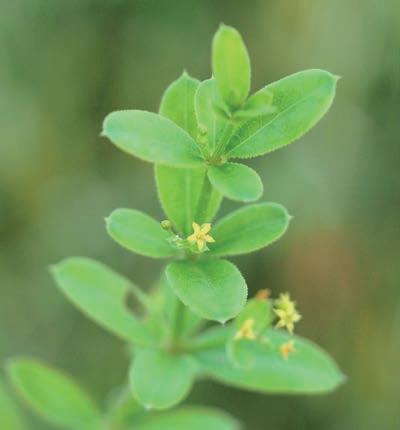
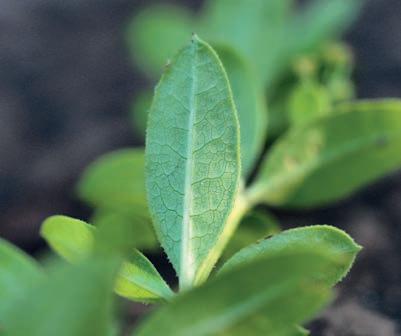
Rubia tinctorum (Madder), showing venation on leaf underside (bottom photo).
Madder is a decidedly scarce plant in Britain, with only a handful of records on the BSBI Distribution Database.
The find got me thinking about possible origins of the plant. Obviously the most parsimonious answer was that in the last decade a former plot-holder had planted some for home dyeing purposes (this practice seems to be on the increase). However, the allotment secretary was certain this was not the case and the plot had been untended for several years. We then discussed other possibilities, including the chance of this being a relic from former Madder cultivation for the Winchester dye trade.
Luckily, we have some highly-qualified friends in the archaeological world who were able to do a little research on my behalf. Tracey Matthews, the Winchester City Council Historic Environment Officer, unearthed some references on the historic use of Madder in early-mediaeval Winchester. This includes Madder-stained pottery fragments from Late Saxon/Saxo-Norman contexts in excavations at Northgate House (in the city centre, c.1.5km north-west), with c.300 sherds showing evidence of staining from use as Madder dye pots: this is a significant percentage of the total pottery fragments recorded. Before renaming in modern times, the nearby Tower Street was known as Snithling Street (Street of the Tailors). It is evident that late-Saxon and early-mediaeval Winchester held a thriving textile industry that included the use of Madder dye. Whether it was grown around the city is unclear, but it seems reasonable to assume that domestic or artisanal cultivation occurred to serve this trade and that the all-powerful Church at that time was a key consumer of Madder-dyed cloth. It is of note that the allotment site is on former church land.
Commercial-scale Madder cultivation appears not to have taken off in Britain. It was the Dutch who really put the effort in and their Madder trade, centred on Zealand, was highly profitable in the 17th century (see www.suzannedekel.com/post/amadder-history). Attempts at wholescale production in Britain were made in Deptford, Romney Marsh and Wisbech (Thirsk, 1970) but none seems to have made a dent in the lucrative Dutch trade. The development of artificial dyes in the 19th century seems to have ruined the Madder cultivation industry almost overnight.
Interestingly, D.E. Allen (1982) provides some commentary on an early record of ‘a madder’ from 1568 by William Turner, who stated ‘the farest and greatest that ever I saw groweth in the lane of [sic] beside Wynchester in the way to Southampton’. Allen postulates that, rather than what was previously thought of as an anomalous record of Rubia peregrina (being some way distant from native coastal Hampshire populations), this might actually be a relic of former R. tinctorum cultivation. Allen mentions that there is documentary evidence from a 12th-century census of two ‘waranchiers’ (dealers or dyers of Madder) living in the city at that time, and an early 13th-century record also mentions this occupation. There is also evidence that Madder was cultivated around Winchester and nearby Alresford in the 14th century. It is quite possible then that this 1568 plant may be a relic from former cultivation.
Does this prove that my modern allotment plant is a survivor of an ancient Madder industry in Winchester? No, it doesn’t of course. However, it does at least indicate that the current distribution of some of our plant species may be explained by examining our social, cultural and industrial history. Plants can tell us so much about the places in which we live. Oh, and allotments are well-worth an explore.
References
Allen, D.E. 1982. A probable sixteenth-century record of Rubia tinctorum L. Watsonia 14: 177. Brewis, A., Bowman, P. & Rose, F. 1996.
The Flora of Hampshire. Harley Books, Colchester. Murphy, R.J. 2009.
Fumitories of Britain and Ireland. BSBI Handbook No.12. Botanical Society of the British Isles, London. Stace, C.A. 2019. New Flora of the British Isles (4th edn).
C & M Floristics, Middlewood Green, Suffolk. Thirsk, J. 1970. Seventeenth-century agriculture and social change. The Agricultural History Review, Volume 18, Supplement 1970.










